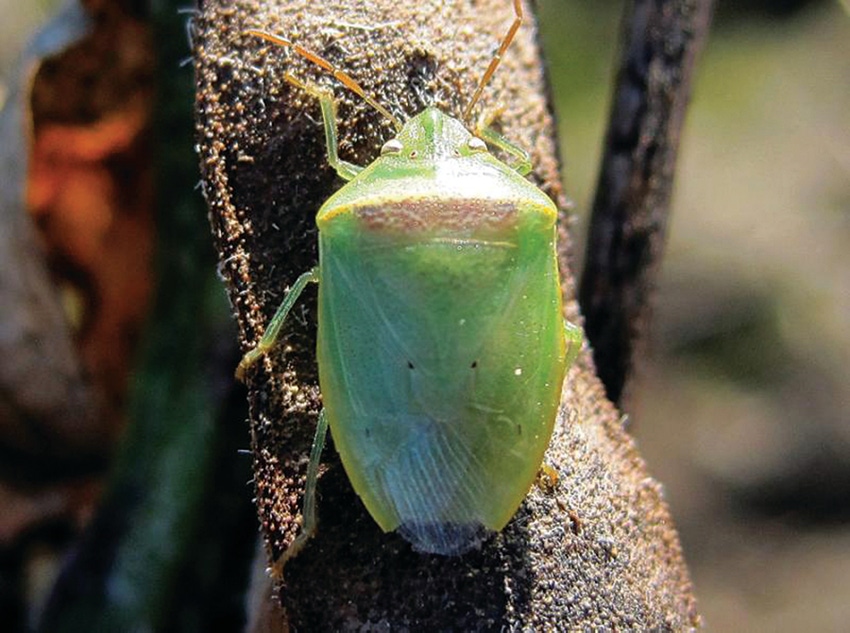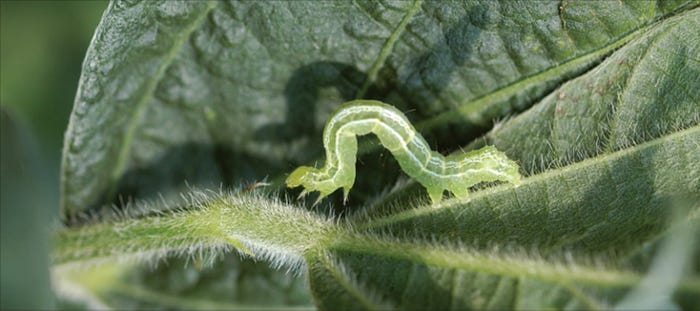
With the 2016 Mid-South soybean crop now history, regional entomologists are offering growers a glimpse of the insects they’re likely to deal with in 2017, along with recommendations for dealing with those pests.
LOUSIANA OUTLOOK The main insect challenges for Louisiana soybean growers are red banded stink bugs and soybean loopers. The state experienced a mild winter, and red banded stink bug populations were very high in 2016.
“Unlike the southern green stink bug and the green stink bug, the red banded stink bug doesn’t diapause during winter and migrates immediately into soybeans,” says Louisiana State University Entomologist Jeff Davis at Baton Rouge. “It feeds primarily on legumes, so we found it very early in clover throughout the state.
“The red banded stink bug is tolerant to many insecticides. Pyrethroids do a great job of cleaning out other stink bug species, but not the red banded stink bug. Bifenthrin products work very well, and acephate remains our main go-to insecticide. Some pyrethroid pre-mixes, such as Endigo and Leverage, work well, but they often flare our second major pest problem, the soybean looper. Growers can use softer chemistries for loopers, including Intrepid and Prevathon, which preserve beneficials.”
Unfortunately, growers have seen control slippage throughout the Mid-South for almost all insecticide classes on soybean loopers, Davis says, noting that part of the problem is application.
“Soybean loopers feed from the inside of the internal canopy, so they’re down in the middle of the plant. If we don’t use a high water volume application, and/or if we go too fast across the field, the insecticide just stays in the top third of the canopy. We need to fine-tune our applications for better canopy penetration and better control.”
Other insect problems for Louisiana soybean growers include corn earworms in the northern part of the state. And this past season, fall armyworms built up on grasses and moved into soybeans after growers were finally able to get into the field following wet weather to spray weeds. “We had an unusually high green cloverworm population this past year; these are sometimes misidentified as soybean loopers,” Davis says.
Growers need to fine-tune applications to insure that applications for soybean loopers penetrate the crop canopy where the insects feed.
Tennessee Cover Crops
More Tennessee growers are planting cover crops, which require an adjustment in insect management, particularly when the cover crops are not burned down until very near planting or after planting.
“Insects will build up and migrate into soybeans from cover crops, particularly legumes such as vetch or winter peas,” says Scott Stewart, Extension entomologist at Jackson. “Especially in those situations, I recommend growers use an insecticide seed treatment.”
The state’s kudzu bug problem continues to expand geographically, but not in intensity. “I expect further expansion if we have another mild winter,” he says. “The good news is that we have a naturally-occurring fungus that is killing them off. It has done a remarkable job, in some cases, of keeping high populations in check.
“Even though we were fortunate to have an unusually light stink bug year in 2016, we need to watch for them in 2017. We also need to keep an eye on our normal slate of defoliating caterpillars, including soybean loopers and cloverworms, and treat when population levels reach economic threshold.”
Mississippi Insects
Mississippi’s top three soybean insect problems are the stink bug complex, soybean loopers, and cotton bollworms. Severity of these pests changes, depending on the year, but typically these are the top three yield robbers for producers.
The state saw an influx of red banded stink bug from the south in 2016. This insect requires different management because it is much more damaging than common stink bugs (southern green stink bug, green stink bug, and brown stink bug). It also has a lower threshold than Mississippi’s normal stink bug species.
“The red banded stink bug is a game changer for soybeans,” says Angus Catchot, Mississippi Extension entomologist at Mississippi State University. “It’s harder to control and infests fields later, compared to our regular species. We have to hit it early, often with tank mixtures such as acephate or Belay plus bifenthrin. We frequently have to come back with another application in seven days.
“The redbanded stink bug is very sensitive to cold winters, which can beat back the insect pest and we might not see it for a while. Before 2016, we hadn’t seen it at economic levels since 2009. But it must be a consideration for 2017.”
Soybean loopers are probably the state’s next most predictable pest, Catchot says. “These defoliators migrate up every year. We spray a significant amount of acreage every year, and we have a lot of chemistries that make them easy to control. However, we may be beginning to see some tolerance to the diamides (Besiege, Prevathon). They’re still working, but we’re seeing a shorter residual, and leaving more in the field than in the past. We may have to alternate with other products, such as Intrepid Edge or Steward.”
Corn earworm populations fluctuate yearly, Catchot says. “For the last eight years, Mississippi soybean growers have sprayed for some every year. The diamides are our preferred chemistry for corn earworms.”
About the Author(s)
You May Also Like




